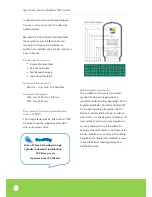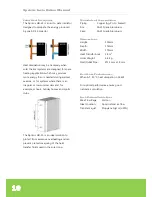
Apricus Installation Manual
4
Evacuated Tube Solar Thermal Collectors are
able to capture the available Solar Energy
and then transfer it as Thermal Energy to the
water heating system, thereby raising the
temperature in the hot water storage
cylinder, and offsetting the reliance to on
alternative fuels (such as coal, gas, oil or
electric) to provide hot water. Up to 70% of
the domestic hot water requirements can be
met by the Apricus Solar Collectors.
Since solar radiation levels depend upon
both the season and the daily weather
conditions it is always necessary to
incorporate a back-up water heater (typically
standard fossil fuel boilers or electric
immersion heaters) to ensure there is a
sufficient supply of hot water all year round.
Key Components of the Solar
Thermal System
Solar Energy is collected when the sunlight
strikes the black selective absorber contained
inside the evacuated tubes of the Solar
Collector.
Each tube contains a copper heat-pipe that
is in contact with the absorber. The heat-
pipe contains a small quantity of water
under a vacuum environment that allows the
water to start boiling at temperatures as low
as 30°C. The water vapour generated when
boiling rapidly rises to the top of the heat
pipe where it condenses and transfers its
thermal energy to the condenser and into
the copper header pipe within the manifold.
Fig. 2
Schematic showing the basic layout of a simple solar thermal
system.
The condensed fluid then flows back down
the heat pipe and is re-heated, thereby
restarting the thermal cycle again.
A circulating pump moves the heat transfer
fluid (a propylene-glycol anti-freeze mixture)
through the copper header pipe within the
manifold and back to the storage cylinder. A
solar heat exchanger coil within the storage
cylinder transfers the thermal energy from
the heat transfer fluid into the water within
the storage cylinder. The cooled fluid then
returns to the collector manifold to be re-
heated.
The operation of the solar loop is controlled
with a temperature differential electronic
controller. This ensures that solar fluid is
only circulated in the solar loop when there
is useful energy to transfer from the
collector into the storage cylinder.
Back-up heating using a conventional fossil
fuel boiler or electrical immersion should
also be provided for periods when solar
radiation is unable to meet the total hot
water demand.





































